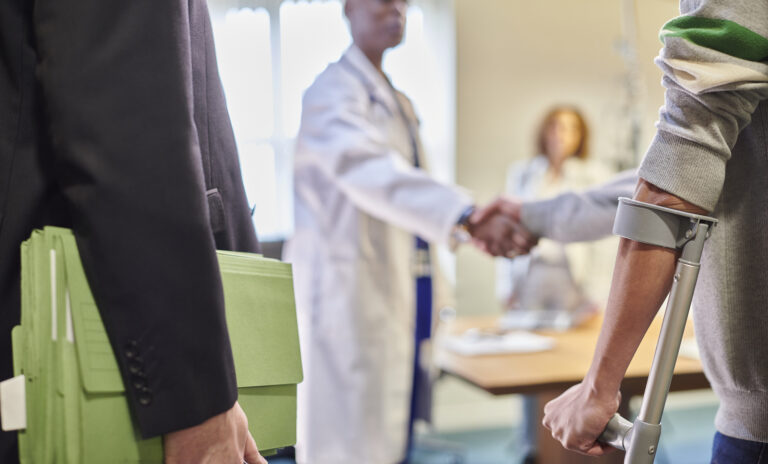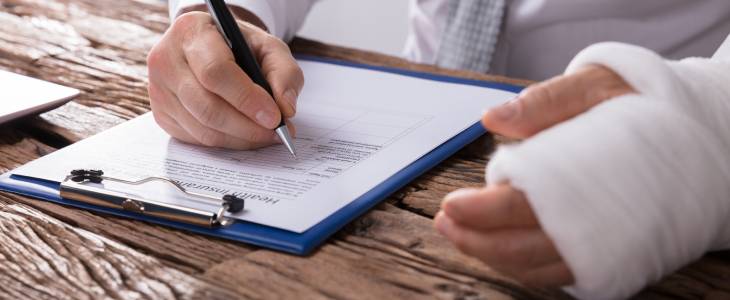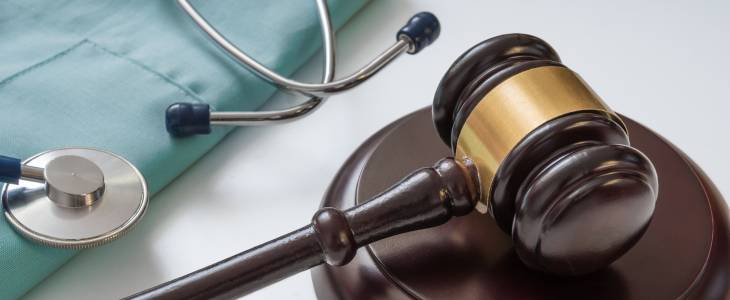What Is a Personal Injury Claim?
A personal injury claim is a legal process that allows an individual who has been hurt by another person’s negligence to seek compensation for their losses. “Negligence” means failing to use reasonable care, such as running a red light, leaving a spill on a store floor, or failing to maintain safe equipment at a worksite.
Common examples of personal injury cases in North Dakota include:
- Motor vehicle collisions — including car, truck, motorcycle, and pedestrian accidents
- Oilfield and industrial accidents — frequent in western North Dakota’s energy regions
- Slip and fall incidents — in stores, restaurants, or private homes
- Workplace injuries — where negligence contributed to unsafe conditions
- Product liability cases — involving defective machinery or consumer products
Personal injury law exists to hold negligent parties accountable and to help victims recover the financial and emotional losses caused by the accident. A successful claim can cover both immediate expenses and the long-term impact on your quality of life.
To prove a personal injury case, four key elements must usually be established:
- The defendant owed you a duty of care.
- That duty was breached through careless or wrongful action.
- The breach directly caused your injury.
- You suffered measurable damages as a result.
Each of these elements requires evidence, something our attorneys carefully document and build from the start of your case.
What Should I Do After an Accident or Injury?
Your actions immediately after an accident can make a significant difference in your recovery and your claim’s outcome. Here’s a step-by-step guide to protecting yourself and your legal rights:
- Get medical help immediately. Even if you think your injuries are minor, symptoms such as concussions, soft tissue injuries, or internal bleeding may take time to appear. Prompt medical care also creates a record that connects your injuries to the incident.
- Report the incident. File a police report for vehicle collisions, notify your supervisor about workplace accidents, or alert the property owner about a fall or other injury. This documentation provides important proof later.
- Collect and preserve evidence. Take photos of the scene, the hazard, vehicle damage, and your visible injuries. Keep damaged items such as torn clothing or broken equipment.
- Get witness information. If anyone saw what happened, write down their names and contact details. Witness statements can help verify your version of events.
- Avoid discussing fault. Be polite, but do not apologize or speculate about what caused the accident. Statements made early can be misinterpreted and used against you later.
- Keep a personal record. Write down what you remember, including the time, location, conditions, and how the injury has affected your daily life.
- Contact a personal injury lawyer early. An attorney can protect your rights from the beginning, handle insurance communications, and prevent costly mistakes.
Taking these steps early helps preserve evidence and shows insurers and courts that you took your injury seriously.

Who Can Be Held Liable for My Injuries?
Determining liability, or legal responsibility, is often one of the most complex parts of a personal injury claim. Depending on the situation, several parties could share responsibility for an accident:
- Negligent drivers who cause crashes through speeding, distraction, or intoxication
- Employers or contractors who fail to provide safe workplaces, especially in oilfield and construction settings
- Property owners who ignore dangerous conditions, such as icy walkways or poor lighting
- Product manufacturers that produce unsafe tools, machinery, or household goods
- Government entities responsible for unsafe road design or maintenance
In many cases, multiple parties contribute to the harm. For example, a trucking company might be liable alongside the driver if it failed to maintain its fleet properly. Identifying all responsible parties is key to maximizing your recovery.
How to File a Personal Injury Claim in North Dakota
While every case is different, most personal injury claims in North Dakota follow a similar process.
1. Initial consultation and investigation
Your attorney will meet with you to understand the facts, injuries, and potential sources of liability. From there, they will gather medical records, police reports, photos, and witness statements.
2. Notice and insurance claim
Most cases start by filing a claim with the at-fault party’s insurance company. The insurer will then assign an adjuster to investigate the claim.
3. Settlement negotiations
Once your attorney calculates your damages, they’ll send a demand letter to the insurer outlining the facts, liability, and compensation sought. Negotiations may go through several rounds before reaching a settlement.
4. Filing a lawsuit if necessary
If settlement negotiations fail, a lawsuit may be filed in civil court. The litigation phase includes discovery, where both sides exchange information, followed by possible mediation or trial.
5. Resolution
Most cases resolve before trial, but if necessary, your attorney will present evidence to a jury to secure fair compensation.
Throughout this process, your lawyer handles all communication, paperwork, and deadlines, ensuring nothing falls through the cracks.
Understanding Fault and Comparative Negligence in North Dakota
North Dakota follows a modified comparative negligence rule under N.D.C.C. § 32-03.2-02. This means:
- You can recover compensation as long as you are less than 50% at fault for the accident.
- Your total recovery is reduced by your percentage of fault.
For example, if you are awarded $100,000 but are found 25% at fault, your recovery would be $75,000.
Comparative negligence often becomes a key issue in cases involving car crashes or shared property maintenance responsibilities. Insurers frequently attempt to assign a higher percentage of blame to reduce payouts. Having a knowledgeable attorney ensures your side of the story is supported with credible evidence, such as accident reconstruction or expert testimony.

What Damages Can You Recover After an Accident?
Damages are the measurable and non-measurable losses that result from an injury. North Dakota allows injury victims to pursue several categories of compensation:
Economic damages
These are the tangible costs associated with your injury, such as:
- Ambulance, hospital, and rehabilitation bills
- Physical therapy and prescription medications
- Lost wages and loss of future earning capacity
- Property damage or replacement costs
- Out-of-pocket expenses related to transportation or home modifications
Non-economic damages
These compensate for intangible losses that affect your well-being and quality of life:
- Pain and physical suffering
- Emotional distress or anxiety
- Loss of enjoyment of life
- Permanent disability or scarring
- Damage to relationships (loss of consortium)
Punitive damages
In limited cases involving intentional misconduct or extreme negligence, the court may award punitive damages to punish the wrongdoer and discourage similar conduct.
Factors That Influence the Value of Your Claim
The value of a personal injury claim can depend on:
- The severity and permanence of your injuries
- The clarity of fault and available evidence
- Your medical treatment and recovery timeline
- How your injuries affect your ability to work and live normally
- The insurance coverage limits of the responsible party
Our attorneys carefully evaluate every factor to ensure your claim reflects both your current and future needs.
How Long Do You Have to File a Claim?
North Dakota law generally gives injury victims six years from the date of the accident to file a personal injury lawsuit. This time limit, known as the statute of limitations, is among the longer deadlines in the U.S., but waiting too long can still jeopardize your case.
Some claims, however, have shorter deadlines, such as:
- Wrongful death claims – typically two years
- Claims against government agencies – three years and may require notice within 180 days
Exceptions That May Extend Filing Deadlines
Certain circumstances can “toll,” or pause, the statute of limitations:
- The injured person is under 18 at the time of the accident.
- The at-fault party leaves the state or hides to avoid service.
- The injury is discovered later, such as in medical negligence or toxic exposure cases.
Because these exceptions are narrow and fact-specific, it’s always best to consult an attorney as soon as possible to preserve your rights.
Do You Need a Personal Injury Attorney?
While it’s possible to file an insurance claim on your own, personal injury law can be complex. Insurance companies often rely on their own legal teams to protect their bottom line. Having a skilled advocate on your side helps balance the process.
At Pringle & Herigstad, P.C., we:
- Investigate every detail of your accident and gather critical evidence
- Communicate directly with insurance adjusters so you don’t have to
- Accurately calculate damages to reflect the full scope of your losses
- Negotiate aggressively for fair settlements
- Take your case to court when necessary to secure justice
We understand that your health and future are on the line, and we’ll handle every legal aspect so you can focus on healing.
Common Mistakes to Avoid During the Claims Process
Even well-intentioned actions can harm your claim. To protect yourself, avoid these common errors:
- Delaying medical care or missing appointments. Gaps in treatment allow insurers to argue your injuries aren’t serious.
- Accepting quick settlement offers. Early offers often undervalue your long-term needs.
- Posting on social media. Photos or comments about your recovery can be taken out of context.
- Not documenting expenses. Keep every bill, receipt, and record of missed workdays.
- Failing to get legal advice. Without guidance, it’s easy to overlook key steps or underestimate your claim’s worth.
Avoiding these mistakes can significantly improve your chances of obtaining a fair outcome.
How Pringle & Herigstad, P.C. Can Help You
Since 1909, Pringle & Herigstad, P.C. has represented injury victims across North Dakota with a deep commitment to justice and client care. With offices in Minot and Grand Forks, our firm combines local knowledge with decades of courtroom experience.
When you work with us, you’ll receive:
- Personalized attention. We take the time to understand your story and goals.
- Comprehensive investigation. Our team gathers police reports, medical evidence, and witness testimony to strengthen your case.
- Transparent communication. You’ll always know where your case stands and what to expect next.
- Proven advocacy. We’re prepared to negotiate firmly or take your case to trial if that’s what justice requires.
We handle all personal injury cases on a contingency fee basis, meaning you owe no attorney fees unless we win compensation for you.
Contact Our North Dakota Personal Injury Lawyers
If you’ve been injured because of someone else’s negligence, you don’t have to go through this process alone. At Pringle & Herigstad, P.C., we’ll stand by your side, explain your rights, and fight for the compensation you deserve.
Contact us to schedule a free consultation. We serve clients throughout North Dakota, including Minot, Grand Forks, Williston, Bismarck, and surrounding areas. Let us help you take the next step toward recovery and peace of mind.

